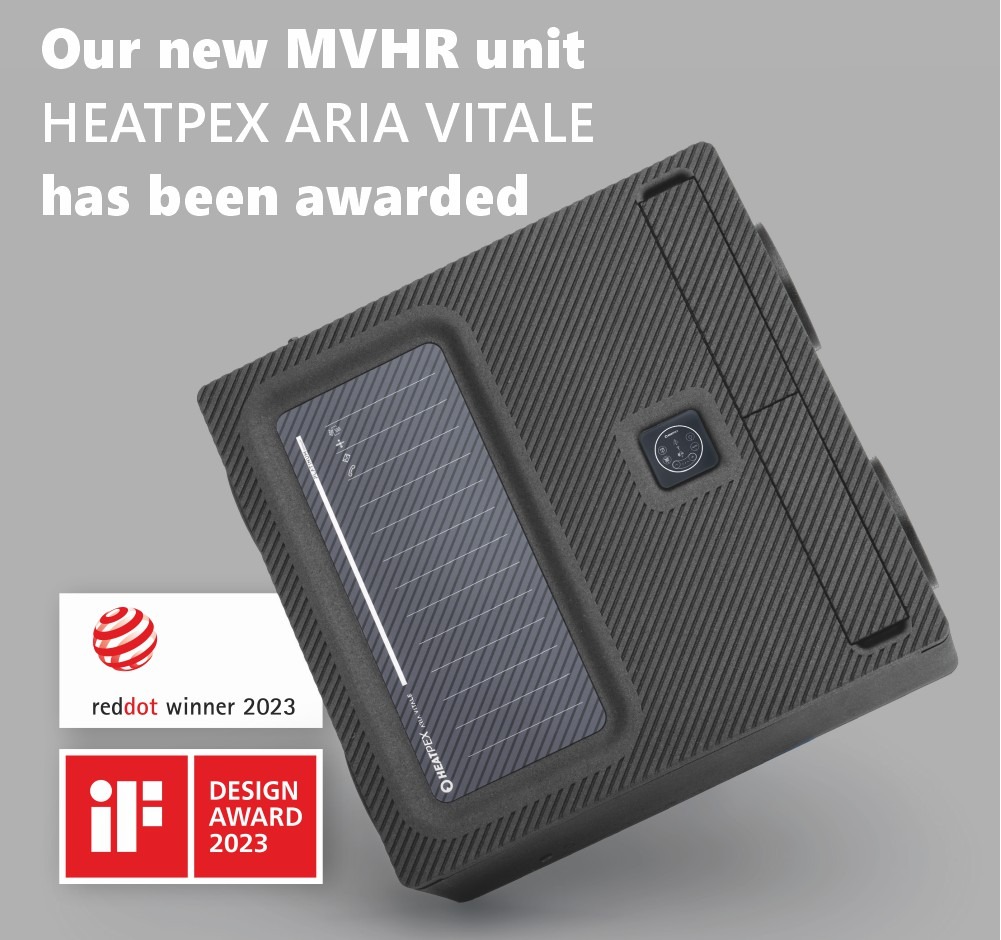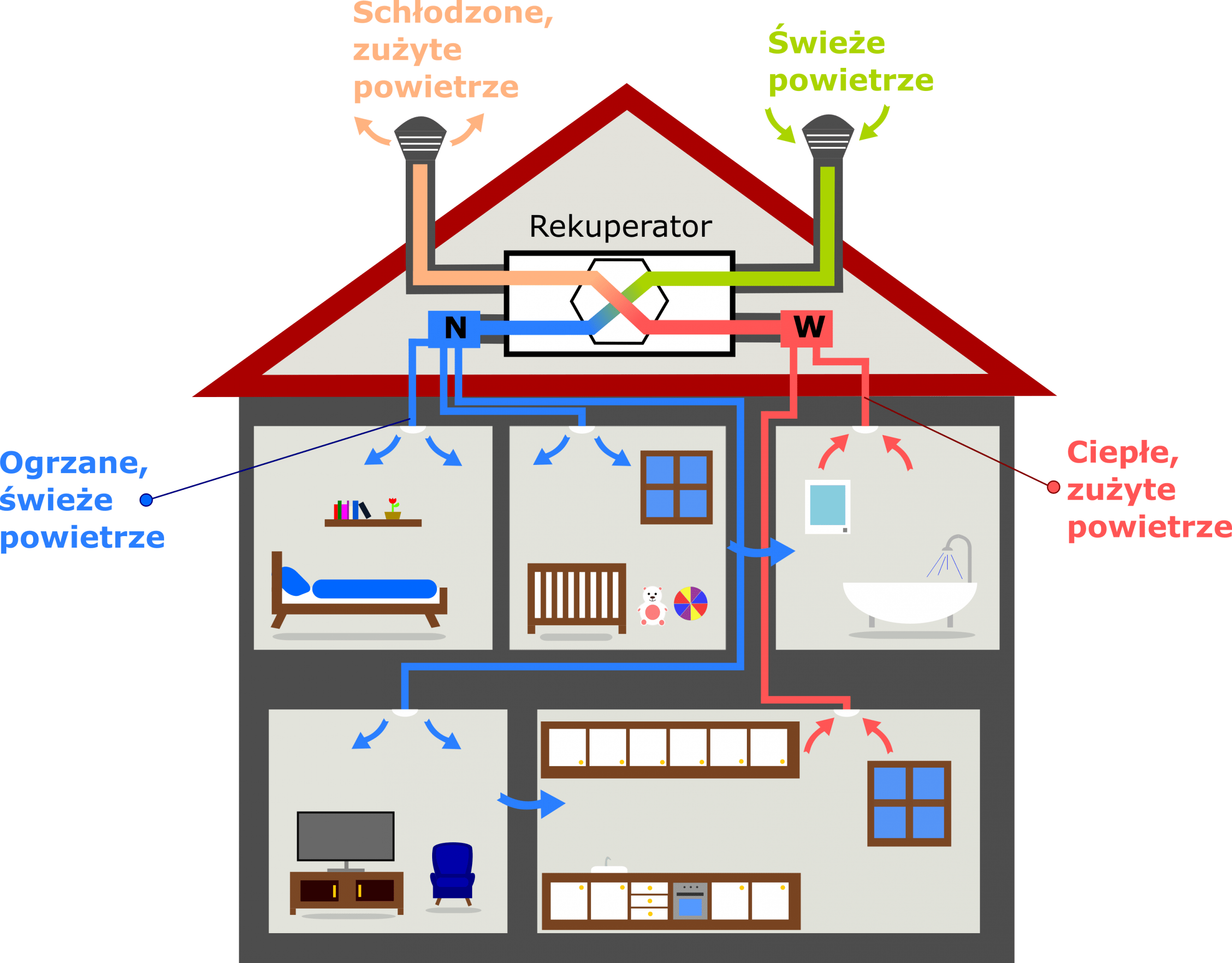
ARIA VITALE heat recovery ventilation unit
02.03.2023
MVHR SYSTEM
28.09.2020
Effective ventilation is a guarantee of our well-being. The role of ventilation is to supply buildings with fresh air from the outside and remove used, polluted air. By breathing, we breathe in oxygen and we exhale carbon dioxide, which should be treated as pollution. In addition to carbon dioxide, other pollutants appear. When cooking, we release many different, not always pleasant smells, and drying laundry or bathing leads to a significant increase in moisture in the space around us. All these pollutants must be removed, while supplying the house or apartment with fresh air, rich in oxygen necessary for life.
We spend a large part of our lives indoors and indoor air quality has a significant impact on our health. Malfunctioning and inadequate ventilation results in malaise, headaches and dizziness, irritation of the nasal mucosa and throat, allergies, and other diseases of the upper respiratory tract. Bad ventilation or the lack of it also affects the technical condition of the building. The moisture that is not removed from the rooms leads to the gradual destruction of the walls of our house and is a perfect environment for the development of fungi and bacteria.
While we have no direct influence on the quality and type of ventilation in our workplace, it is worth ensuring proper ventilation in our home. Thanks to this, it will become a place where we can breathe freely after a hard day’s work.

The most common type of ventilation in Polish homes is gravity ventilation. It is passive ventilation, based on the forces of nature – mainly the chimney effect. For gravity ventilation to function properly, 2 factors are necessary.
The first is the possibility of fresh air entering the interior of the building, or infiltration. In the past, infiltration took place through all kinds of leaks in the building – cracks, inaccurate connections between partitions, gaps in the windows. In today’s technologically advanced construction, this type of leakage is practically non-existent. To ensure the supply of fresh air, it is necessary to use, for example, window ventilators or simply opening the windows.
The second factor necessary to ensure air flow is the temperature difference between the inside of the building and its surroundings. Warmer air inside the house has a lower density than outside air. Warm air rises up and is removed through the ventilation chimneys, and cold air from the manor flows in its place. It can be easily concluded that the force of exchange depends on the magnitude of the temperature difference between the inside of the house and its surroundings. In winter, ventilation is very intense and a large amount of air is removed from the building, while in summer there is no exchange.

It can be seen from the above description that gravity ventilation, with its simplicity, has a number of disadvantages or even disadvantages. The first thing is dependence on weather conditions. The intensity of ventilation is influenced by the temperature outside the window, which is why we are not able to adjust it to our needs. In winter, ventilation is very intense, which means that we remove a large amount of heated air from our house, and a cold stream from outside flows inside the air inlets. The result is high heat loss and a lot of energy is required to heat the house. Closing the air inlets is not a solution as cold air will flow through the outlet grille. Closing all possible inlets is very harmful for us. The level of moisture in the air increases and the used air with a high CO2 content is not removed, making us feel worse. Contrary to appearances, such a situation is quite common. We close the diffusers in the windows, we cover the ventilation grilles, because we do not want the icy winter air to blow into our house, heated to a pleasant temperature. Even if we allow free air inflow from outside, intensive ventilation in winter will lead to the drying of the atmosphere, which is also harmful to us.
In summer, ventilation is ineffective because the temperature difference is too small. Only opening the windows will help, which is not always comfortable – outside the window there may be noise, dust may float, and insects, e.g. mosquitoes, may fly in when we sit in the evening with the light on. The opposite situation to that in winter may occur – the air will be humid, stuffy and heavy.
Gravity ventilation works optimally only in spring and autumn, when the temperature difference between our house and its surroundings is several degrees. For the rest of the year, it is ineffective, does not provide us with adequate comfort and leads to large energy losses.

Mechanical ventilation with heat recovery is the answer to the problems of gravity ventilation. Unlike gravity ventilation, which is passive, MVHR is forced ventilation. There are two fans in the unit, whose task is to set the air in motion, regardless of the prevailing conditions. The first is responsible for blowing fresh air from the outside to the inside of the building, the second – for extracting used air. In addition to the fans, the MVHR unit also includes a heat exchanger. The cool outdoor air flowing through it is warmed by the warm air removed from our home.
The principle of the MVHR system is shown in a simplified manner in the diagram below. Fresh air is drawn into the house through an air intake located on the roof or exterior wall of the building. Through the ventilation duct connecting the air intake with the MVHR, it goes to the heat exchanger, where it is heated from the air removed from the building. Then the air is sent to the distribution box, where it is divided into streams reaching individual rooms. The air supply is carried out in “clean” rooms, ie those where we stay for a long time and no pollution is formed in them. These are the living room, rooms, bedrooms. Air flows through the house from “clean” to “dirty” rooms. Dirty rooms are those where contamination occurs. Usually it is a kitchen, bathrooms and various types of utility rooms. From there, the air is drawn in and goes through the ventilation ducts to the exhaust distribution box. There, the individual streams merge into one and go to the heat exchanger, where the energy is transferred to the supply air. Then the used air is removed from the building through an air intake located on the roof or external wall.

MVHR has a number of advantages that place it over gravity ventilation
1. Continuous ventilation regardless of weather conditions, with intensity adjusted to the needs
As the air circulation is forced by the MVHR unit fans, the ventilation is continuous and independent of the air temperature outside the window. We choose the degree of intensity, depending on our needs. We plan a party for more people at home, we cook or dry the laundry – we can increase the degree of ventilation by increasing the fan speed. We are going on vacation and we will be away for several days – we are reducing the intensity. However, most of the time we are satisfied with the standard settings and we will forget about the fact that we have a MVHR at home.
2. High comfort
This advantage follows directly from the previous point. As the ventilation works continuously, fresh air is constantly supplied to the house and contaminants are removed on an ongoing basis. Thanks to this, we feel fresh and comfortable all the time, and the concept of stuffiness becomes foreign to us. We are not affected by headaches and fatigue caused by insufficient ventilation. Additionally, thanks to MVHR, we don’t have to open windows to ventilate our house. By leaving the windows closed, we avoid unpleasant noise from the street, protect the interior from dust coming from a nearby construction site and block the way of flies, mosquitoes and other vermin entering our house. Of course, if we want to open the window, nothing stands in the way. Open windows will not significantly disturb the operation of the MVHR system, they will only reduce the degree of heat recovery
3. Filtration of impurities
Each MVHR is equipped with a set of filters. They will effectively protect us from external pollution, such as dust, smog or pollen, allowing us to enjoy clean air in our home. Their role is also to protect the MVHR fans against premature failure. One should only remember about their periodic replacement if we want the air in the interior to be free from contamination and the MVHR to work without failure for many years. The filtration capacity of MVHR will be especially appreciated by allergy sufferers and people sensitive to air quality.

MVHR is the recovery of energy. In ventilation, we are talking about recovering energy from the warm air removed from the home. Thanks to this, we incur less heating expenditure. We do not have to heat the completely cold air supplied from the outside, because it is already pre-heated in the MVHR exchanger to a temperature of several degrees. The degree of savings on the fuel itself depends on many factors, so it is difficult to clearly define what our savings will be. They depend on the outside temperature, the type of fuel used, the insulation of our home, and finally the temperature we like to keep inside. However, it should be remembered that saving on fuel alone is not the only one that MVHR gives us. We save on the construction of ventilation chimneys and thus obtain more space that we can use. The use of MVHR allows us to use a cheaper boiler with less power. The windows that we install in our home will also be cheaper, because we do not have to use diffusers. In some rooms you can even install windows without the possibility of opening, i.e. fixes. A well-made MVHR installation will also allow you to remove unwanted costs in the future related to the repair of the building when excess moisture or even fungus appears.
